Overview on subwoofer types
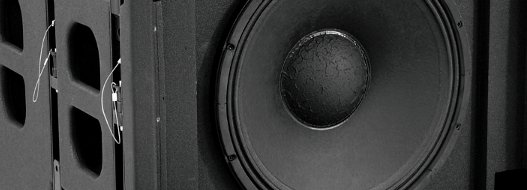
The human ear is mainly adapted to the frequency range where speech is transmitted. Frequencies below this frequency range are less noted although the same physical level is present. In practice, this effect requires higher bass power e. g. by more powerful subwoofers, more subs or a mixture of both. As speakers generally have a low efficiency comparable to a halogen lamp, manufacturers try to achieve the highest efficiency by optimized housing shapes. But not every housing shape is suitable for every event location and audience. The following article should help to find the suitable subwoofer type.
1. Introduction
The loudspeaker celebrates its 150th anniversary based on the invention of the telephone by Philipp Reis in the year 1861. Already in the year 1878, the electro-dynamic loudspeaker was patented. This kind of loudspeaker is still built into most speaker-systems today.
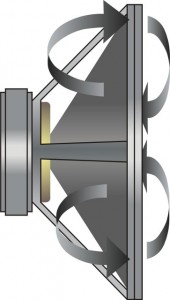 If such a loudspeaker is operated without housing, an acoustic short-circuit is produced because the sound waves produced by both membrane sides are eliminated by each other. The volume is clearly reduced, especially the lower frequencies. A pragmatic use is not possible like this so that diverse types of loudspeaker housings for different applications were developed.
If such a loudspeaker is operated without housing, an acoustic short-circuit is produced because the sound waves produced by both membrane sides are eliminated by each other. The volume is clearly reduced, especially the lower frequencies. A pragmatic use is not possible like this so that diverse types of loudspeaker housings for different applications were developed.
![]() The easiest way to avoid the acoustic short-circuit is the (open) sound wall. If the louspeaker is mounted into a sufficiently big, massive plate, the sound waves of both membrane sides cannot eliminate each other directly. This solution is not so practical so that it can only be found in permanent installations, e. g. 100-volt-systems.
The easiest way to avoid the acoustic short-circuit is the (open) sound wall. If the louspeaker is mounted into a sufficiently big, massive plate, the sound waves of both membrane sides cannot eliminate each other directly. This solution is not so practical so that it can only be found in permanent installations, e. g. 100-volt-systems.
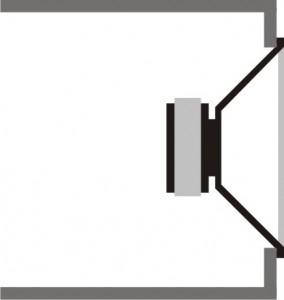 Far more often, the folded sound wall, normally the rear panel can be found, where parts of the opposite plate are removed. Old tube-radios were built like this due to temperature reasons and many guitar amplifiers still today are constructed in this way. PA speaker systems, however, are not constructed this way.
Far more often, the folded sound wall, normally the rear panel can be found, where parts of the opposite plate are removed. Old tube-radios were built like this due to temperature reasons and many guitar amplifiers still today are constructed in this way. PA speaker systems, however, are not constructed this way.
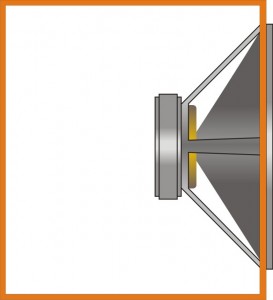 The closed housing is another, very simple housing type. Imagine a cube or cuboid having a hole for the speaker on one side. Simple Hi-Fi speaker-systems and small systems for public areas or pubs are often constructed like this. Subwoofers, however, are not constructed this way because the efficiency is far too low. The main reason for this is that the flexible air cushion in the housing absorbs a considerable part of the sound pressure level. This effect is even more visible at low frequencies because then the membranes move most.
The closed housing is another, very simple housing type. Imagine a cube or cuboid having a hole for the speaker on one side. Simple Hi-Fi speaker-systems and small systems for public areas or pubs are often constructed like this. Subwoofers, however, are not constructed this way because the efficiency is far too low. The main reason for this is that the flexible air cushion in the housing absorbs a considerable part of the sound pressure level. This effect is even more visible at low frequencies because then the membranes move most.
2. Bassreflex subwoofers
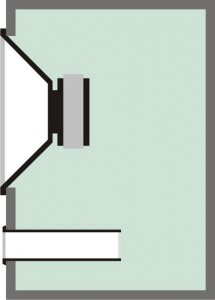 Coming from the closed housing, the bassreflex-housing has an additional hole, mostly on the front panel and next to the bass speaker. This hole is called channel or port and leads into the inner housing, it is not just a “hole”. The size of the hole and the length of the channel are chosen in a way that the air cushion in the rest of the housing works as resonator. In the area of the resonance frequency, a higher sound pressure level can be achieved in this way. Below this frequency, an acoustic short-circuit is produced by the channel while above this frequency no positive or negative effect can be noted. In practice, the resonance frequency is chosen in range where the mounted speaker already shows lower levels at lower frequencies. In this way, the bandwidth of the loudspeaker can be extended by approximately one octave.
Coming from the closed housing, the bassreflex-housing has an additional hole, mostly on the front panel and next to the bass speaker. This hole is called channel or port and leads into the inner housing, it is not just a “hole”. The size of the hole and the length of the channel are chosen in a way that the air cushion in the rest of the housing works as resonator. In the area of the resonance frequency, a higher sound pressure level can be achieved in this way. Below this frequency, an acoustic short-circuit is produced by the channel while above this frequency no positive or negative effect can be noted. In practice, the resonance frequency is chosen in range where the mounted speaker already shows lower levels at lower frequencies. In this way, the bandwidth of the loudspeaker can be extended by approximately one octave.
Bassreflex-subwoofers are mainly used for small to medium-sized rooms and small open-air events. The react directly and precisely but are limited in respect to maximum level and throw range. Due to their sound characteristics they are especially suitable for live music.
Omnitronic offers a variety of bassreflex-subwoofers. The AZ-series includes the AZ-112, AZ-115 and AZ-118 with one loudspeaker at different speaker-sizes. The PAS-series accordingly includes the PAS-121, PAS-151 and PAS-181. Furthermore, the PAS-151S with sloped woofer and thus smaller housing and the PAS-152 with two loudspeakers are available.
The subwoofers of PSSO’s Compact Line Arrays are also bassreflex-systems. The CLA-115 can also be flown whereas the CLA-118 is only meant for floor use. The PSSO CSA-112 subwoofer also features a bassreflex-housing.
Tip:
The Omnitronic PAS-151S is especially suitable for restaurants or smaller event locations. Due to its comparatively low height, it can be placed anywhere and produces a considerable sound pressure due to its dual voice-coil.
The Omnitronic PAS-121 convinces in a cluster of four or more subwoofers. The small membrane diameter grant a very fast reaction time and thus a very clear sound reproduction. The reduced depth of the loudspeaker is compensated by coupling-effects in the cluster. In this way, four PAS-121 in a cluster produce better results than two widely positioned PAS-152.
3. Bandpass subwoofers
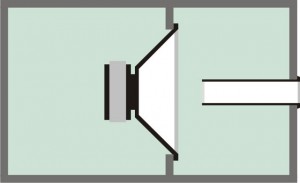 These subwoofer constructions are very popular. As the name already implies, bandpass subwoofers have a high efficiency within a certain frequency range mostly not larger than one octave. Bandpass subwoofers can be constructed in different ways. Normally, bandpass systems provide two chambers, one including the loudspeaker. This chamber may be closed or forms a bassreflex-housing. The bandpass effect is created by the second chamber positioned in front of the loudspeaker hole. This additional chamber features a bassreflex hole. The transmission range can be extended by the combination of two bassreflex chambers.
These subwoofer constructions are very popular. As the name already implies, bandpass subwoofers have a high efficiency within a certain frequency range mostly not larger than one octave. Bandpass subwoofers can be constructed in different ways. Normally, bandpass systems provide two chambers, one including the loudspeaker. This chamber may be closed or forms a bassreflex-housing. The bandpass effect is created by the second chamber positioned in front of the loudspeaker hole. This additional chamber features a bassreflex hole. The transmission range can be extended by the combination of two bassreflex chambers.
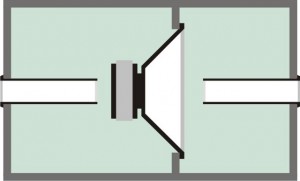 The advantages of the bandpass subwoofer can be found in the higher efficiency as bassreflex housings and their smaller size as horn constructions. Bandpass subwoofers are suitable for small to medium-sized rooms where high sound pressure levels are needed.
The advantages of the bandpass subwoofer can be found in the higher efficiency as bassreflex housings and their smaller size as horn constructions. Bandpass subwoofers are suitable for small to medium-sized rooms where high sound pressure levels are needed.
The Omnitronic PAS-series includes two double ventilating bandpass subwoofers PAS-15 and PAS-18. PSSO offers the CSA-115.
Tip:
The PSSO CSA-115 combined with the CSA-218 and CSA-228 is recommended as mobile PA-system for little and medium-sized events where demanding background sound is required. Together with an amplifier of the Omnitronic HDA-series, effective 2.1 systems can be realized with the amplifier also working as active crossover.
4. Horn subwoofers
Horns can be constructed in different way whereas they all have in common that a kind of flare is attached to the loudspeaker. Similar to a paper flare in front of the mouth, the horn bundles the sound and thus increases the efficiency. The basic horn subwoofer has a closed housing with a horn directly attached in front of the loudspeaker. This construction is also called front loaded horn. Many tweeters and the horn loudspeakers of the 100-volt-systems are constructed this way. Subwoofers do rarely have a front loaded horn although these are used as exponential horn.
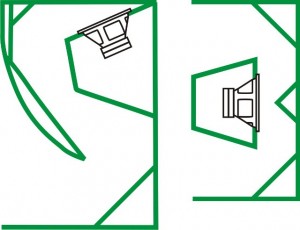 Mostly, the subwoofer horn is folded in any way in order to reduce the housing size to acceptable dimensions. The crossover frequency as an important feature of horn constructions depends on the size of the horn opening. As the horn shape is mathematically defined (for bass depending on the exponential function) a certain length of the horn is determined for low frequencies. In the early days of PA-technology when the driver power was still very limited, some bizarre big horn constructions were made for cinemas.
Mostly, the subwoofer horn is folded in any way in order to reduce the housing size to acceptable dimensions. The crossover frequency as an important feature of horn constructions depends on the size of the horn opening. As the horn shape is mathematically defined (for bass depending on the exponential function) a certain length of the horn is determined for low frequencies. In the early days of PA-technology when the driver power was still very limited, some bizarre big horn constructions were made for cinemas.
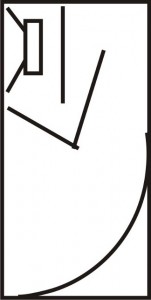 Many years ago, subwoofers with speakers radiating directly to the front but with a horn on the rear panel were very popular. These were called rear-loaded-horns. Folded horns can be built in a more compact way with speakers opposite to the radiation direction and having two folded horns at the same time.
Many years ago, subwoofers with speakers radiating directly to the front but with a horn on the rear panel were very popular. These were called rear-loaded-horns. Folded horns can be built in a more compact way with speakers opposite to the radiation direction and having two folded horns at the same time.
Horn constructions convince by their mere power. Due to the horn directivity, they also throw at a greater distance than other housing shapes. This is why they are very popular for large open-air events. Their enormous bass pressure is also popular in discotheques and dance events. An advantage of these systems is that the folded horns are relatively slow when compared to other subwoofer constructions.
The two horn constructions of Omnitronic’s PAS-series have folded horns in the classic alignment. Regarding their construction, PAS-118 and PAS-218 are identical only that the PAS-218 is a double PAS-118.
Tip:
Horns also like to be among each other. The lower crossover frequency of PAS-118 and PAS-218 can be optimized when being put together. Stereo bass is a luxury one must not have at any price because the human ear cannot locate the bass frequencies precisely. Additionally, the low frequency range (also of horns) is radiated undirected, not like the mids and highs. Clearly, it may be a good alternative to put all subwoofers together and operate them mono.
5. Hybrid subwoofers
All subwoofer constructions have their advantages and disadvantages, higher efficiency or higher throw distance, but also slower reaction speed and worse sound. One way to find a balance was the development of hybrid subwoofers combining the strength of two different constructions and minimizing the disadvantages. The combination of bassreflex and horn subwoofer is very popular and can be found in the PSSO SUB-2150 and SUB-2180. In this way, a better sound can be reached with a higher efficiency. The throw distance is far better than of bassreflex subwoofers.
Tip:
The PSSO SUB-2150 and SUB-2180 can be laid on the floor in order to increase the efficiency. Due to the sloped speakers it makes a difference on which side the subwoofer is laid. Just try.
Due to the lower membrane size, the SUB-2150 is ideal for live applications demanding a quick reaction speed. The SUB-2180 is ideal for dancing events demanding a powerful bass volume.
6. Overview
| Sound | Efficiency | Size/weight | |
| Bassreflex | ++++ | + | ++++ |
| Bandpass | ++ | ++ | ++ |
| Horn | + | ++++ | + |
| Hybrid | +++ | +++ | +++ |
.


